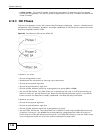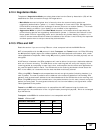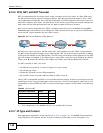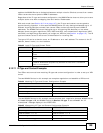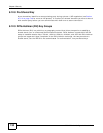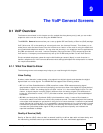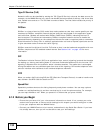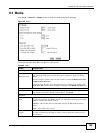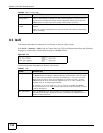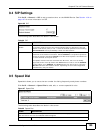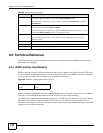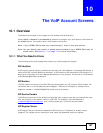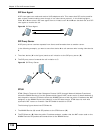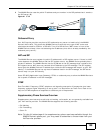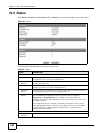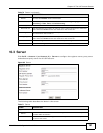
Chapter 9 The VoIP General Screens
WiMAX Device Configuration User’s Guide
154
9.3 QoS
This section describes the features of the Quality of Service (QoS) screen.
Click VoIP > General > QoS to set up Type of Service (ToS) and Differentiated Services (Diffserv)
settings for voice traffic transmission through the WiMAX Device.
Figure 85 QoS
The following table describes the labels in this screen.
Packet Loss
Concealment
Packets may be dropped due to an overwhelming amount of traffic on the
network. Some degree of packet loss will not be noticeable to the end user, but
as packet loss increases the quality of sound degrades. Select this to have the
WiMAX Device to improve the voice quality when packet loss occurs.
T.38 Static Jitter
Length
T.38 is an ITU-T standard that VoIP devices use to send fax messages over the
Internet.
Select the number of milliseconds for the jitter buffer size used for transmitting
T.38 fax messages.
Table 66 Media (continued)
LABEL DESCRIPTION
Table 67 QoS
LABEL DESCRIPTION
SIP ToS/DiffServ Enter the DSCP value you want to mark on all outgoing SIP packets generated by
the WiMAX Device for DiffServ-enabled networks. Since DiffServ uses the first 6
bits of the 8-bit IP ToS field to represent the DSCP value, enter here the 6-bit
DSCP value you want to mark in hexadecimal (in a format of 0x00), and the
WiMAX Device will then automatically append 2 bits '0' to make a whole 8-bit
ToS field value for all outgoing SIP packets.
For example, if you enter 0x2E, it is 101110 in binary for DSCP. The WiMAX
Device converts it to 10111000
in binary and marks on the IP ToS field of all the
outgoing SIP packets.
RTP ToS/DiffServ Enter the DSCP value you want to mark on all outgoing VoIP data packets
(including both RTP and T.38 UDPTL packets) generated by the WiMAX Device for
DiffServ-enabled networks.



